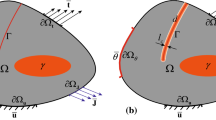Abstract
This paper describes the formulation and numerical implementation of the three-dimensional dual boundary element method (DBEM) for the thermoelastic analysis of mixed-mode crack problems in linear elastic fracture mechanics. The DBEM incorporates two pairs of independent boundary integral equations; namely the temperature and displacement, and the flux and traction equations. In this technique, one pair is applied on one of the crack faces and the other pair on the opposite one. On non-crack boundaries, the temperature and displacement equations are applied.
Similar content being viewed by others
References
Aliabadi, M.H. and Rooke, D.P. (1992). Numerical Fracture Mechanics, Computational Mechanic Publications, Southampton.
Boley, B.A. and Weiner, J.H. (1960). Theory of Thermal Stresses, John Wiley & Sons, New York.
Brebbia, C.A. and Dominguez, J. (1992). Boundary Elements, An Introductory Course, Computational Mechanic Publications and McGraw–Hill.
Brebbia, C.A., Telles, J.C.F. and Wrobel, L.C. (1984). Boundary Element Techniques, Springer–Verlag, Berlin.
Broek, D. (1987). Elementary Engineering Fracture Mechanics, Kluwer Academic Publishers, Dordrecht.
Cruse, T.A. (1977). Mathematical formulations of the boundary integral equation method in solid mechanics. Technical Report AFOSR–TR–77–1002. Pratt and Whitney Aircraft Group.
Das, B.R. (1968). Thermal stresses in a long cylinder containing a penny–shaped crack. International Journal of Engineering Science 6, 497–516.
Florence, A.L. and Goodier, J.N. (1963). The linear thermoelastic problem of uniform heat flow disturbed by a penny–shaped insulated crack. International Journal of Engineering Science 1, 533–540.
Mi, Y. and Aliabadi, M.H. (1992). Dual boundary element method for three–dimensional fracture mechanics analysis. Engineering Analysis with Boundary Elements 10, 161–171.
Murakami, Y. et al. (1987). Stress Intensity Factors Handbook, Pergamon Press, London.
Olesiak, Z. and Sneddon, I.N. (1959). The distribution of therml stress in an infinite elastic solid containing a penny–shaped crack. Archive for Rational Mechanics and Analysis 4, 238–254.
Portela, A., Aliabadi, M.H. and Rooke, D.P. (1992). The dual boundary element method: Effective implementation for crack problems. International Journal for Numerical Methods in Engineering 33, 1269–1278.
Prasad, N.N.V., Aliabadi, M.H. and Rooke, D.P. (1994). The dual boundary element method for thermoelastic crack problem. International Journal of Fracture 66, 255–272.
Rizzo, F.J. and Shippy, D.J. (1977). An advanced boundary integral equation method for three–dimensional thermoelasticity. International Journal for Numerical Methods in Engineering 11, 1753–1768.
Author information
Authors and Affiliations
Rights and permissions
About this article
Cite this article
Dell'Erba, D., Aliabadi, M. & Rooke, D. Dual boundary element method for three-dimensional thermoelastic crack problems. International Journal of Fracture 94, 89–101 (1998). https://doi.org/10.1023/A:1007572726097
Issue Date:
DOI: https://doi.org/10.1023/A:1007572726097




